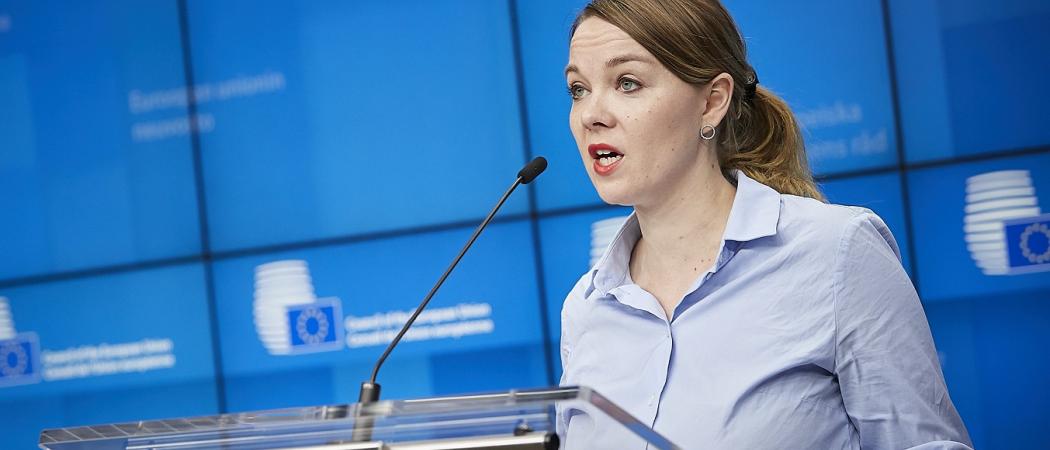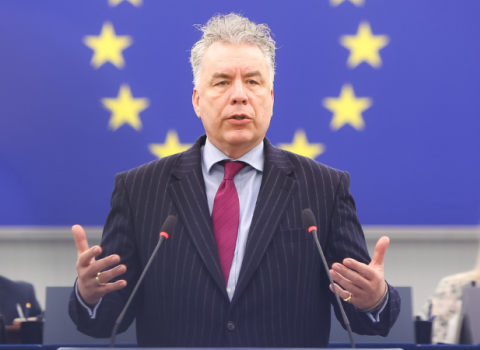Member states strike a deal on which funding schemes should be coordinated with Horizon Europe, the proposed €94.1B research programme

Finnish minister for economic affairs Katri Kulmuni chaired the EU council meeting on Friday. Photo: European Union
EU member states have struck a deal on how the Horizon Europe research programme should be combined with 14 other EU programmes, such as fisheries and the space programme.
The EU Council agreement on synergies lays out which other funding programmes should be linked to Horizon Europe and why. They include the EU’s massive agricultural fund, the space programme and the Digital Europe capacity-building programme.
The final decision on Horizon Europe’s ties to other programmes, which the council still has to work out with the European Parliament, will influence how the European Commission designs research grants after the programme launches in 2021. Identifying synergies that boost impact is now more pressing, given that Horizon Europe looks unlikely to get the €94.1 billion budget originally proposed by the European Commission. There have been suggestions that research could be cut by as much as €12 billion, but ambassadors will this week discuss Finnish proposals for a much smaller cut.
Common goals
The agreement does not go into great detail about how Horizon Europe would work alongside all these programmes, that’s for the commission to decide. But it does provide a rationale for why each programme is relevant, and identifies common goals.
A common thread is that while Horizon Europe can develop ideas all the way from basic research to design (the innovation element), other programmes are better placed to put ideas into practice. Another theme is information sharing: where two programmes touch on the same field, lessons learned while implementing one can improve management of the other.
For example, while the Connecting Europe Facility invests in transport, energy and telecoms networks, Horizon Europe pays for research in all these fields. Similarly, Digital Europe will purchase artificial intelligence systems and high-performance computing equipment, both of which feature in the research programme.
The Common Agricultural Policy is also on the list, which is to be expected, given that the commission in its original proposal for Horizon Europe decided to ring-fence €10 billion for agricultural research, in part to make up for cuts to farm subsidies.
The 14 areas identified in the document are:
- The Common Agricultural Policy, which provides direct payments to farmers and funds rural development
- European Maritime and Fisheries Fund, which supports the coastal economy.
- European Regional Development Fund, which aims to develop regional economies and has a particular emphasis on research, innovation, and technological development
- The European Social Fund Plus, which will pull together a variety of existing programmes to boost employment, job quality and public health.
- The Connecting Europe Facility, which pays for improvements to Europe’s transnational transport, energy and telecommunications networks.
- The Digital Europe Programme, which will see the EU buy advanced digital technologies like AI and high-performance computing and make them available to small businesses and universities.
- The Single Market Programme, which aims to improve conditions for small businesses and help them take advantage of the EU’s single market.
- The Programme for Environment and Climate Action (LIFE), which provides partial funding projects in fields such as renewable energy, natural resource management, and managing natural disasters.
- The Erasmus Programme, which pays for students to study abroad.
- The European Space Programme, which will manage the EU’s joint efforts with the European Space Agency, such as the Copernicus earth observation programme or the Galileo satellite navigation system.
- The Neighbourhood, Development and International Cooperation Instrument and the Instrument for Pre-accession Assistance, which support the EU’s neighbours and countries about to join the bloc.
- The Internal Security Fund and the Border Management Fund, which contribute to law enforcement and protecting the EU’s external borders.
- InvestEU, which has the EU provide guarantees for European Investment Bank loans, including for research and innovation.
- The Emissions Trading Scheme, which promotes carbon offsetting and includes an Innovation Fund for low-carbon technologies.





 A unique international forum for public research organisations and companies to connect their external engagement with strategic interests around their R&D system.
A unique international forum for public research organisations and companies to connect their external engagement with strategic interests around their R&D system.